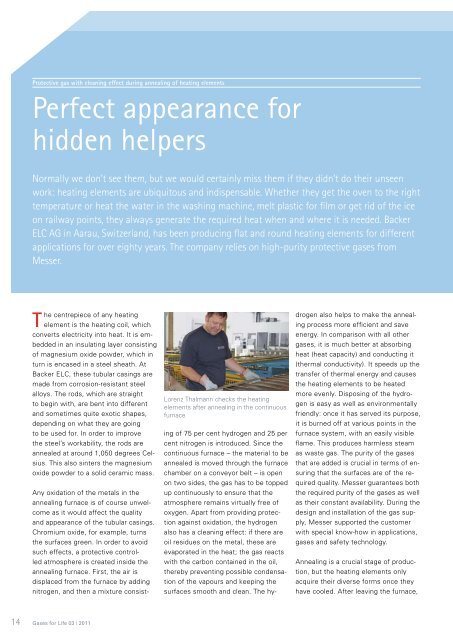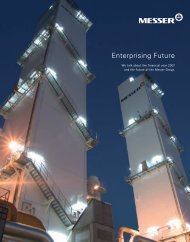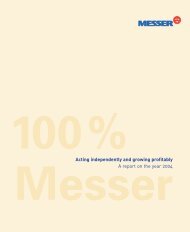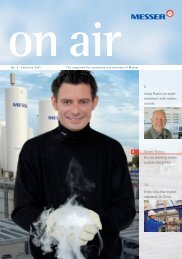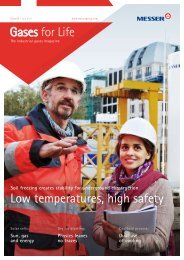Gases for Life - Messer Group
Gases for Life - Messer Group
Gases for Life - Messer Group
You also want an ePaper? Increase the reach of your titles
YUMPU automatically turns print PDFs into web optimized ePapers that Google loves.
Protective gas with cleaning effect during annealing of heating elementsPerfect appearance <strong>for</strong>hidden helpersNormally we don’t see them, but we would certainly miss them if they didn’t do their unseenwork: heating elements are ubiquitous and indispensable. Whether they get the oven to the righttemperature or heat the water in the washing machine, melt plastic <strong>for</strong> film or get rid of the iceon railway points, they always generate the required heat when and where it is needed. BackerELC AG in Aarau, Switzerland, has been producing flat and round heating elements <strong>for</strong> differentapplications <strong>for</strong> over eighty years. The company relies on high-purity protective gases from<strong>Messer</strong>.The centrepiece of any heatingelement is the heating coil, whichconverts electricity into heat. It is embeddedin an insulating layer consistingof magnesium oxide powder, which inturn is encased in a steel sheath. AtBacker ELC, these tubular casings aremade from corrosion-resistant steelalloys. The rods, which are straightto begin with, are bent into differentand sometimes quite exotic shapes,depending on what they are goingto be used <strong>for</strong>. In order to improvethe steel’s workability, the rods areannealed at around 1,050 degrees Celsius.This also sinters the magnesiumoxide powder to a solid ceramic mass.Lorenz Thalmann checks the heatingelements after annealing in the continuousfurnaceAny oxidation of the metals in theannealing furnace is of course unwelcomeas it would affect the qualityand appearance of the tubular casings.Chromium oxide, <strong>for</strong> example, turnsthe surfaces green. In order to avoidsuch effects, a protective controlledatmosphere is created inside theannealing furnace. First, the air isdisplaced from the furnace by addingnitrogen, and then a mixture consistingof 75 per cent hydrogen and 25 percent nitrogen is introduced. Since thecontinuous furnace – the material to beannealed is moved through the furnacechamber on a conveyor belt – is openon two sides, the gas has to be toppedup continuously to ensure that theatmosphere remains virtually free ofoxygen. Apart from providing protectionagainst oxidation, the hydrogenalso has a cleaning effect: if there areoil residues on the metal, these areevaporated in the heat; the gas reactswith the carbon contained in the oil,thereby preventing possible condensationof the vapours and keeping thesurfaces smooth and clean. The hydrogenalso helps to make the annealingprocess more efficient and saveenergy. In comparison with all othergases, it is much better at absorbingheat (heat capacity) and conducting it(thermal conductivity). It speeds up thetransfer of thermal energy and causesthe heating elements to be heatedmore evenly. Disposing of the hydrogenis easy as well as environmentallyfriendly: once it has served its purpose,it is burned off at various points in thefurnace system, with an easily visibleflame. This produces harmless steamas waste gas. The purity of the gasesthat are added is crucial in terms of ensuringthat the surfaces are of the requiredquality. <strong>Messer</strong> guarantees boththe required purity of the gases as wellas their constant availability. During thedesign and installation of the gas supply,<strong>Messer</strong> supported the customerwith special know-how in applications,gases and safety technology.Annealing is a crucial stage of production,but the heating elements onlyacquire their diverse <strong>for</strong>ms once theyhave cooled. After leaving the furnace,14 <strong>Gases</strong> <strong>for</strong> <strong>Life</strong> 03 | 2011


